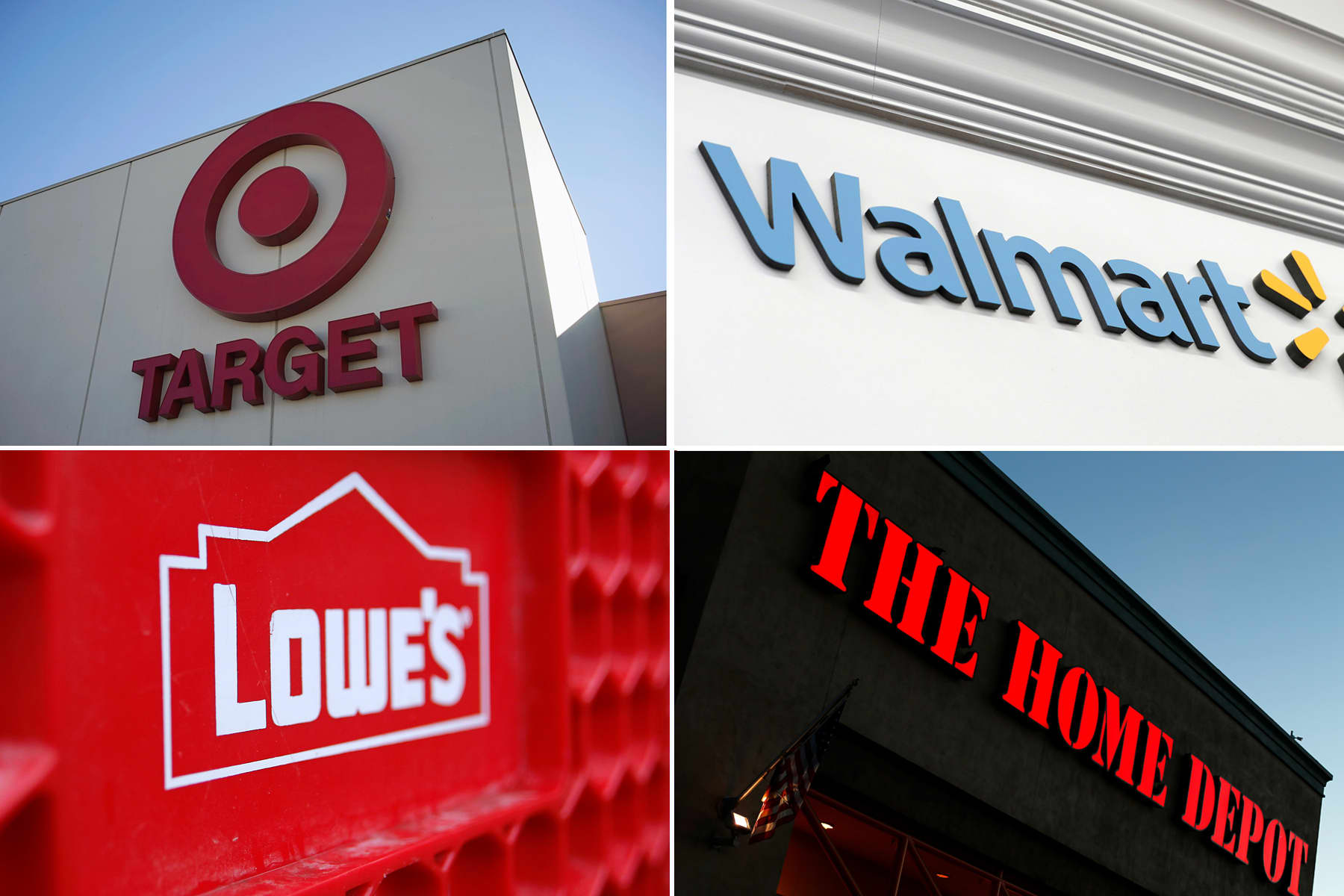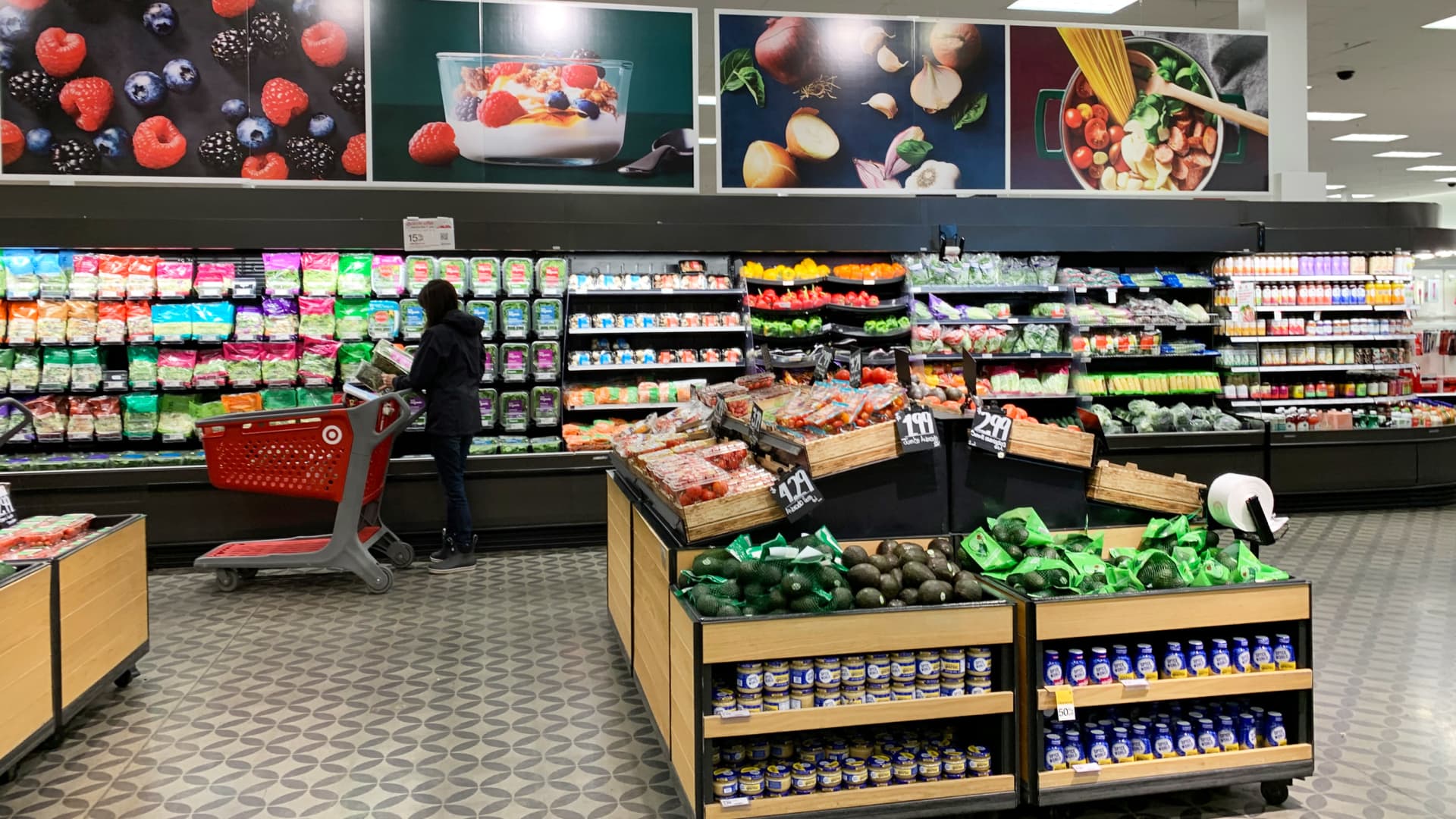Target wants shoppers to think of it for groceries as retailer braces for leaner spending
About 21% of Target’s annual sales come from the food and beverage category, but its grocery aisles have taken on added importance as shoppers buy fewer discretionary items.
Melissa Repko | CNBC
For many Americans, a trip to Target brings to mind a shopping cart filled with throw pillows, makeup or a cute outfit.
The retailer wants more customers to think of it when checking off the grocery list, too.
related investing news


Only 21% of Target’s annual sales came from food and beverage in the most recent fiscal year, according to the company’s financial filings. That’s a sharp difference from rival Walmart, which gets nearly 60% of its annual sales from the grocery aisles.
Yet as inflation-wary shoppers watch their budgets and focus on needs instead of wants, grocery has gained importance as a driver of foot traffic. Investors will learn this week if Target could help make up for softer sales of apparel, electronics and home goods by selling more boxes of pasta, gallons of milk and cartons of eggs. The company will report earnings before the bell Wednesday.
Target will post results as the company’s stock has fallen, driven in part by challenging pandemic comparisons and its own inventory missteps. Shares of Target closed Monday at $160.57, down nearly 30% from its 52-week high.
The big-box retailer also hopes by drawing shoppers for essentials like gallons of milk, it can nudge purchases of discretionary items that shoppers otherwise would not have bought.
“It’s actually a gateway to the rest of the store,” Chief Food and Beverage Officer Rick Gomez said in an interview with CNBC. “It drives traffic to the store. It drives traffic to our site. And then while they’re picking up what they need food- and beverage-wise, they’ll browse through the rest of the store and maybe pick up a few things at Ulta [Beauty at Target] or a few things in apparel.”
A ‘Tarzhay’ spin on groceries
On a recent trip to a Minneapolis area grocery store, Gomez surveyed displays of colorful fruits and vegetables. Nearby, shoppers could order freshly sliced turkey at the store’s full deli counter or order a custom birthday cake at a bakery.
The store captures Target’s grocery ambitions, even though it offers a much larger mix of food than many of the retailer’s other stores. The retailer’s stores vary in size and so do its grocery departments.
Since stepping into his food and beverage role a little over two years ago, Gomez has overseen Target’s efforts to raise the quality of the grocery department. He said that began with some tough truths: Customers weren’t satisfied.
“We were doing focus groups and one of our guests said, ‘You know, I know Target sells food and beverage, but it kind of feels like an afterthought. It feels a little bit like a bolt-on. It doesn’t have ‘Tarzhay magic’ that the rest of the store has,” Gomez said.
“It was a little disheartening, but rather than get frustrated and get disappointed about it, we said, ‘You know what, let’s use that as a rallying cry,'” he said.
Target struggled with out-of-stock items in the department, even before the pandemic walloped the supply chain, he said. Fruits and vegetables weren’t always fresh. The grocery department didn’t capture a celebratory or seasonal flair like other parts of the store.
Target can now offer more reliability with a new distribution center in Maryland that opened in October, he said. It hired more employees with grocery expertise and raised its produce specifications to lengthen freshness, improve taste and boost presentation, such as making sure avocados are a consistent size.
He said that Target has added more items to Good & Gather, its primary private label grocery brand that launched in 2019 and to Favorite Day, a line of snacks and desserts that debuted in 2021.
It has riffed off the model of Trader Joe’s by coming up with creative items that can’t be found elsewhere, such as s’mores trail mix and an avocado toast-flavored chopped salad kit. Some items are seasonal, too, like a peach jelly bean-flavored whipped cream for Easter.
Gomez credited those changes and others for fueling sales gains. In each of the past two fiscal years, Target has had double-digit sales growth in the food and beverage category.
The segment’s sales as a percentage of Target’s overall annual revenue has stayed relatively flat, but its total sales have spiked. Food and beverage sales totaled $22.9 billion in the fiscal year that ended in January, up about 52% from $15 billion in the year that ended in late January 2020.
Target’s grocery sales matter more as shoppers pull back in other areas. Company leaders said at an investor meeting in January that the retailer took action to address the budget sensitivity they were seeing from consumers. After its aggressive actions to clear through excess inventory, the company stocked up more on food and essentials.
It had about 13% less inventory in discretionary categories compared with a year ago at the end of the fiscal fourth quarter. Target also said it would offer more items at lower price points, such as $3, $5, $10 and $15.
Grocery competition gets tougher
Competition for grocery shoppers has heated up, especially as consumers stretch their budgets. Discounters like Aldi, Lidl and Dollar General are opening more stores, while warehouse clubs like Costco, BJ’s Wholesale and Walmart-owned Sam’s Club have reeled in more members by offering cheaper gas and bulk sizes. Meanwhile, Kroger wants to get bigger by acquiring Albertsons.
Target is the fourth-largest grocer in the U.S., with 5.3% of market share in 2022, according to market researcher Euromonitor. That data does not include online grocery sales, which Target has grown through curbside pickup and its home delivery service, Shipt.
The retailer doesn’t attract as many shoppers doing a big weekly grocery trip as its rivals, said Michael Lasser, a retail analyst for UBS. Yet he said it caters to convenience by selling clothing and toys, and offers value with its expanded private label brands.
“Target has increased its relevance in grocery over the past several years,” he said. “The shopper can get more of its needs satisfied at Target today versus in the past.”
But leaning too much into grocery is a risk, Lasser said. That department drives lower margins than other categories — plus, its cheap chic spin on home goods, apparel and more is a key part of what draws shoppers to its website and stores.
Karen Short, a retail analyst for Credit Suisse, said as a shopper, she doesn’t buy fresh foods from Target. She said it can’t offer the same freshness of grocers that sell more produce and turn over berries and bagged salads more quickly.
If the company expands its produce selection, however, she added, it risks tossing more into the garbage bin.
“That’s Target’s permanent dilemma,” she said.
But Target’s Gomez said the company does have the velocity for fresh food: “The volume is there. The traffic is there.”
Target has another issue in building its grocery business relative to Walmart, Short added. She said over the past few quarters, Target has lost some of the shoppers and store visits it gained during the pandemic as consumers stressed affordability over convenience. She said it has a perception problem, as some link the retailer’s flair with higher prices.
In the Minneapolis area, prices of staples at Target were nearly in line with a Walmart less than two miles away. On most of those items, such as a dozen eggs, a gallon of milk and a box of pasta, Target was about 5 or 10 cents more, according to a CNBC analysis.
On a trip to a Minneapolis store with CNBC, Gomez mentioned a recent advertising campaign about “affordable joy.” He pointed out simplified displays at the end of aisles, which advertise a single low price for items like boxes of cereal.
Value goes beyond price too, Gomez said.
“When times are tough and you’re paycheck to paycheck, you can’t afford to buy food that nobody eats,” he said. “So it’s really important to us that we offer value which is a good price, but also really good quality.”
It’s unclear if Target’s effort to bill itself as a budget-friendly grocer will resonate with consumers.
Prices are top of mind for Megan Harvey, 29, of New York City. She enjoys visiting Target and belongs to its loyalty program, Circle. Yet she and her boyfriend, Ben Horansky, 29, don’t buy groceries there.
Instead, Harvey said she typically goes to the retailer’s store in her Upper East Side neighborhood to buy beauty items, such as facewash, or home goods like bath towels. On Sunday, for example, she stopped in and bought a pack of razors.
Over the past three months, Harvey said she’s made fewer Target visits to limit the temptation of coming in for two items and leaving with 12. The couple decided where to grocery shop after tracking local grocers’ prices on a spreadsheet.
“Target is just not the first place that jumps to mind when I think of grocery shopping,” Horansky said. But he said he may add it to the price spreadsheet and see how it stacks up.
Correction: Target’s food and beverage sales were $22.9 billion in the fiscal year that ended in January, and $15 billion in the prior year. A previous version of this story misstated those figures.
For all the latest business News Click Here

